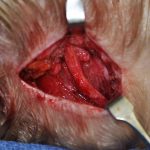Background: Migraine headaches are a common and potentially debilitating disorder. Affecting both men as well as women, they account for a significant amount of lost productivity and a hampered lifestyle for those severely affected. Why migraines occur is still largely unknown. Treatment of migraines is largely done by drug therapies which focus on either prevention or the cessation of an active attack. Unfortunately the effectiveness of many of these drugs is modest at best and they all are not without their side effects.
Despite a longheld belief that the cause of migraines emanates from inside the brain, an alternative cause of some migraines has been proposed and studied in the past decade. This theory advocates that the cause is more peripheral or outside the brain. Peripheral triggers caused by the compression of specific cranial nerves as they exit the skull can be the migraine source for some patients. This discovery was initially made by plastic surgeons who observed that endoscopic browlift patients, who also had pre-existing migraines, were significantly improved due to the surgical dissection of the supraorbital and supratrochlear nerves. This muscular compression theory was concurrently corroborated by the now known and FDA-approved use of Botox injections as an important new migraine treatment.
A specific set of peripheral nerve triggers for migraines have been identified. These include the supraorbital and supratrochlear nerves for frontal migraines, the zygomaticotemporal nerve for temporal migraines and the greater occipital nerve for occipital migraines. A fourth trigger is the nasal septum if there is a contact point between it and the inferior turbinate creating a retrobulbar or orbital migraine. Surgical deactivation of these triggers is based on muscular decompression of the nerves as they course through the muscle.
Case Study: A 50 year-old male had a long history of difficult and debilitating migraines. He suffered an average migraine frequency of three to five per month, often lasting for days. He had been completely worked up by multiple neurologists which ruled out any identifiable cause. He had been through numerous drug therapies including beta-blockers, calcium channel blockers, antiepileptics and antidepressants. He had a very specific area of easily identifiable peripheral triggers in the bilateral occipital areas. His migraines always started at the base of his skull and spread out upward across the back of his head.
He was initially treated with Botox injections in the occipital region in the pin point areas that he could specifically put his finger on. Each side received 20 units. He did not have the onset of a migraine until 3 ½ months later. He then underwent a series of three more Botox injections over the next year and near had a full blown migraine. He received Botox when he felt that a migraine may be starting again. This was always between the 3rd and 4th month after the previous Botox injection.

At one year after surgery, he has not has any migraine episodes. He states he has a few mild headaches but they were infrequent and definitely no migraine in nature. His scalp incisions have healed in a near undetectable manner and remain hidden in his hairline. He has nor received any Botox since surgery.
Case Highlights:
1) For select patients with occipital-based migraines, the peripheral trigger may be muscle entrapment or compression by the semispinalis muscle of the greater occipital nerve branches.
2) Surgical decompression of occipital migraines should only be considered after complete neurologic work-up and management and at least one positive treatment with Botox injections.
3) Surgery for occipital migraines is a relatively straightforward procedure for patients to go through with little to no after surgery pain or after care needed. The biggest risk of greater occipital nerve decompression is that it may not be successful or long-lasting. There are no other negative side effects known.
Dr. Barry Eppley
Indianapolis, Indiana


